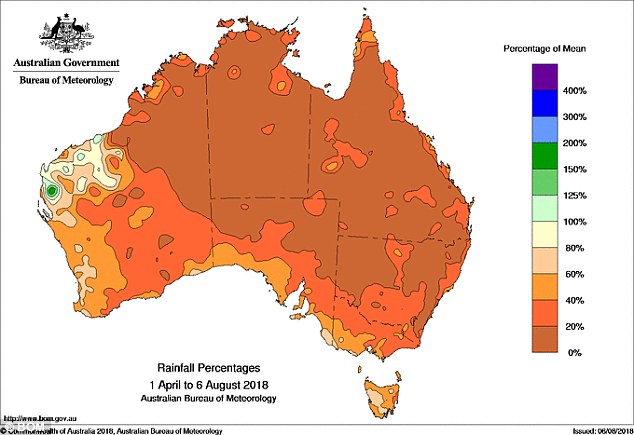Drought In South Australia: The Growing Pressure From Kangaroos

Table of Contents
The Impact of Drought on Kangaroo Populations
The prolonged drought significantly impacts kangaroo populations, affecting their survival and reproductive rates.
Reduced Food Availability
The drought has severely depleted native vegetation, the primary food source for kangaroos.
- Shrinking pastures: Reduced rainfall leads to less nutritious and less abundant plant growth.
- Reduced plant diversity: Drought-resistant species dominate, limiting the variety of food available.
- Increased competition for scarce resources: Kangaroos compete fiercely for the remaining vegetation, leading to malnutrition.
This leads to malnutrition, reduced breeding rates, and increased vulnerability to disease. Weakened kangaroos are more susceptible to parasites and illness, further impacting population numbers. The lack of sufficient forage directly contributes to the overall stress on the kangaroo population, making them more vulnerable to the effects of the drought.
Water Scarcity
Finding sufficient water is a critical challenge during prolonged drought periods for kangaroos.
- Depleted waterholes: Traditional water sources dry up, forcing kangaroos to travel further for water.
- Dry creeks: Waterways become dry, eliminating vital sources of hydration.
- Competition with livestock for limited water resources: Kangaroos compete with livestock for dwindling water supplies, exacerbating the problem.
Dehydration weakens kangaroos, making them more susceptible to predators and disease. The stress of searching for water consumes energy that could otherwise be used for foraging and reproduction. This contributes to the overall decline in kangaroo health and population numbers during periods of drought.
The Economic Impact on Agriculture
The burgeoning kangaroo population, stressed by the drought, significantly impacts South Australian agriculture.
Crop Damage
Hungry kangaroos, struggling to find sufficient native food, turn to crops as a food source, leading to substantial losses for farmers.
- Damage to cereal crops: Kangaroos consume significant quantities of grain crops, resulting in reduced yields.
- Grazing land degradation: Overgrazing by kangaroos can damage pastureland, affecting livestock production.
- Increased pest control costs: Farmers invest heavily in fencing, deterrent methods, and sometimes culling to protect their crops.
This contributes to reduced farm profitability and economic hardship for rural communities. The financial burden of dealing with kangaroo damage places extra strain on already struggling farmers during drought conditions.
Competition for Resources
Kangaroos compete with livestock for the limited remaining resources, further stressing farmers.
- Overgrazing: Kangaroos consume large quantities of pasture, reducing the availability of forage for livestock.
- Depletion of water resources: Competition for water sources between kangaroos and livestock creates conflict and resource scarcity.
- Increased conflict between kangaroos and livestock: Competition can lead to stress, disease transmission, and reduced productivity for farmers.
This necessitates increased investment in fencing and other mitigation measures, adding to the financial strain on farmers already coping with drought conditions.
Environmental Consequences
The impact of the kangaroo drought South Australia extends beyond agriculture, affecting the broader environment.
Ecosystem Imbalance
Overgrazing by kangaroos can lead to land degradation and habitat loss for other native species.
- Soil erosion: Overgrazing removes vegetation cover, leaving soil vulnerable to erosion by wind and rain.
- Loss of biodiversity: The reduction in plant diversity affects the habitat and food sources of other native animals.
- Altered vegetation composition: The dominance of drought-resistant species can lead to a less diverse and less resilient ecosystem.
This disrupts the delicate balance of the South Australian ecosystem, impacting the survival of numerous plant and animal species.
Disease Risk
Stressed kangaroo populations are more susceptible to disease outbreaks.
- Increased risk of disease transmission to livestock: Close contact between kangaroos and livestock increases the risk of disease transmission.
- Potential for zoonotic diseases: Diseases that can spread from animals to humans pose a threat to public health.
This poses a threat to both wildlife and human health, highlighting the interconnectedness of the problem.
Management Strategies and Solutions
Addressing the "kangaroo drought South Australia" requires a comprehensive strategy encompassing several approaches.
Sustainable Culling Programs
Careful management of kangaroo populations through culling is often considered necessary to alleviate pressure on agricultural lands and prevent further ecosystem damage.
- Ethical and sustainable culling practices: Culling must be carried out humanely and sustainably, following strict guidelines.
- Monitoring population numbers: Regular monitoring is essential to ensure culling programs are effective and do not deplete the kangaroo population excessively.
- Minimizing environmental impact: Culling programs should be designed to minimize the impact on the wider environment.
This aims to reduce the pressure on agricultural lands and prevent further ecosystem damage. However, culling needs careful consideration and should only be a part of a wider management strategy.
Water Management Strategies
Improving water availability for both kangaroos and livestock is crucial in mitigating the impacts of drought.
- Constructing artificial water sources: Creating additional water sources can help alleviate water scarcity.
- Efficient water usage in agriculture: Implementing water-efficient irrigation techniques reduces demand on water resources.
- Rainwater harvesting: Collecting and storing rainwater can provide a supplementary water source for both livestock and wildlife.
This can alleviate the pressure on existing resources and mitigate drought impacts.
Community Engagement
Collaboration between farmers, conservationists, and government agencies is essential for effective management.
- Shared strategies: Developing shared strategies that address the needs of all stakeholders.
- Information sharing: Facilitating communication and knowledge exchange among different groups.
- Funding for research and management initiatives: Securing funding for research and implementing management strategies.
A coordinated approach maximizes the effectiveness of interventions.
Conclusion
The ongoing drought in South Australia is placing immense pressure on kangaroo populations and the agricultural sector. The resulting ecological and economic consequences demand a multifaceted approach, combining sustainable culling programs, improved water management, and strong community engagement. Addressing the kangaroo drought South Australia crisis requires urgent action to protect both the environment and the livelihoods of South Australians. We must collaborate to find effective, long-term solutions to manage this complex challenge and ensure the future health of our ecosystem. Let's work together to develop sustainable strategies for mitigating the effects of the kangaroo drought in South Australia and its impact on our communities.

Featured Posts
-
 Kylian Mbappe And Real Madrid A Winning Partnership
May 29, 2025
Kylian Mbappe And Real Madrid A Winning Partnership
May 29, 2025 -
 Paris Rally Marine Le Pen Calls Conviction A Political Maneuver
May 29, 2025
Paris Rally Marine Le Pen Calls Conviction A Political Maneuver
May 29, 2025 -
 Schietincident Venlo Man Overlijdt Aan Verwondingen
May 29, 2025
Schietincident Venlo Man Overlijdt Aan Verwondingen
May 29, 2025 -
 Trump Taps Rubio For Key European Diplomatic Mission
May 29, 2025
Trump Taps Rubio For Key European Diplomatic Mission
May 29, 2025 -
 Diddy Trial Update Ex Employee Claims Combs Threatened To Kill Kid Cudi
May 29, 2025
Diddy Trial Update Ex Employee Claims Combs Threatened To Kill Kid Cudi
May 29, 2025
